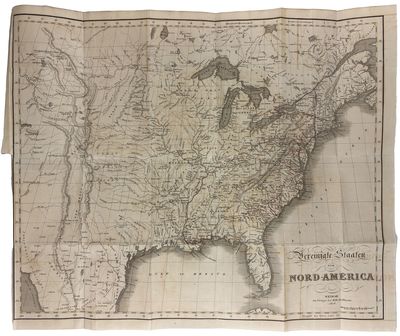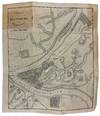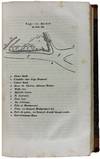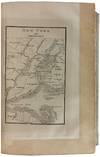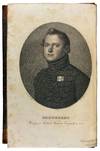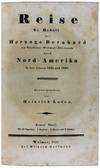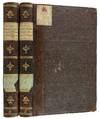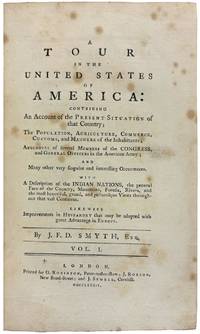Two volumes. 8vo
1828 · Weimar
by BERNHARD, Carl, Prince of Saxe-Weimar-Eisenach (1792-1862); Heinrich LUDEN (1778-1847, editor)
Weimar: Wilhelm Hoffmann, 1828. Two volumes. 8vo. (8 13/16 x 5 1/4 inches). [Vol. I] [ii], xxxi, [1] 317 pp.; [Vol. II] iv, [2], 323, [5] pp. Illustrated with an engraved portrait of Bernhard, 10 engraved maps and plans (including 2 in-text plans of Boston and Quebec), 3 engraved plates and 25 engraved vignettes in the text. Contemporary half sheep over marbled boards, glazed paper spine-labels, marbled end-papers
Provenance: Armorial book-plates of the Bibliothèque des Herrn Grafen von Schönborn-Buchheim in each volume
An indispensable contemporary perspective on transatlantic travel and German-American relations, including an important cartographic representations of the young republic.
Prince Carl Bernhard of Saxe-Weimar-Eisenach had already lived a remarkable public life before embarking for the New World. The youngest son of Goethe's patron Grand-Duke Carl August, he entered the allied armies while still a teenager and, as colonel in Dutch service, led a Nassau brigade at both Quatre-Bras and Waterloo in 1815. After further colonial commands in the Dutch East Indies, he secured leave in 1825 for "a tour of useful observation" across the Atlantic. His journals reveal a disciplined eye for topography and military logistics, tempered by the liberal curiosity of a man raised in the Weimar of Schiller and the early Romantics. Landing at Boston in August 1825, Bernhard struck inland along the brand-new Erie Canal (officially opened only weeks earlier) to Niagara, looped through Lower Canada as far as Québec, then descended the eastern seaboard to Washington and the southern states, wintered in South Carolina and Georgia, pressed on to New Orleans, and finally traveled up the Mississippi and Ohio to Pittsburgh and the Great Lakes, covering some 8,000 miles before sailing home the following September. He thus observed the United States at the dawn of the Jacksonian age, when canals, steamboats and cheap land were accelerating westward migration while sectional tensions over slavery were already plain. On his return the prince placed the notebooks in the hands of Heinrich Luden, the nationalist historian and University of Jena professor famous for lectures that had stirred the Wartburg students in the demonstration of 1817. Luden edited the material, retaining the day-by-day structure but adding explanatory footnotes and an apparatus of ten engraved maps, three copper-plates and twenty-five wood-engraved vignettes-and issued the first edition at Weimar in 1828. An English translation appeared in Philadelphia the same year. Both versions are considered crucial sources on early U.S. infrastructure, frontier society and British North America under George IV. Published amid a surge of German interest in overseas opportunity, Bernhard's frank assessments of land prices, canal tolls, slavery, Indigenous nations and republican politics reached an audience far wider than the princely circle for which they were first penned. Today the 1828 Weimar first edition stands as one of the earliest book-length German accounts of the United States after the War of 1812 and the opening of the Erie Canal, preceding by nearly a generation the classic narratives of Duden (1829) and von Raumer (1845).
Sabin 495; Howes B-385; Clark III:14; Graff 279; Meynen 3358. (Inventory #: 42320)
Provenance: Armorial book-plates of the Bibliothèque des Herrn Grafen von Schönborn-Buchheim in each volume
An indispensable contemporary perspective on transatlantic travel and German-American relations, including an important cartographic representations of the young republic.
Prince Carl Bernhard of Saxe-Weimar-Eisenach had already lived a remarkable public life before embarking for the New World. The youngest son of Goethe's patron Grand-Duke Carl August, he entered the allied armies while still a teenager and, as colonel in Dutch service, led a Nassau brigade at both Quatre-Bras and Waterloo in 1815. After further colonial commands in the Dutch East Indies, he secured leave in 1825 for "a tour of useful observation" across the Atlantic. His journals reveal a disciplined eye for topography and military logistics, tempered by the liberal curiosity of a man raised in the Weimar of Schiller and the early Romantics. Landing at Boston in August 1825, Bernhard struck inland along the brand-new Erie Canal (officially opened only weeks earlier) to Niagara, looped through Lower Canada as far as Québec, then descended the eastern seaboard to Washington and the southern states, wintered in South Carolina and Georgia, pressed on to New Orleans, and finally traveled up the Mississippi and Ohio to Pittsburgh and the Great Lakes, covering some 8,000 miles before sailing home the following September. He thus observed the United States at the dawn of the Jacksonian age, when canals, steamboats and cheap land were accelerating westward migration while sectional tensions over slavery were already plain. On his return the prince placed the notebooks in the hands of Heinrich Luden, the nationalist historian and University of Jena professor famous for lectures that had stirred the Wartburg students in the demonstration of 1817. Luden edited the material, retaining the day-by-day structure but adding explanatory footnotes and an apparatus of ten engraved maps, three copper-plates and twenty-five wood-engraved vignettes-and issued the first edition at Weimar in 1828. An English translation appeared in Philadelphia the same year. Both versions are considered crucial sources on early U.S. infrastructure, frontier society and British North America under George IV. Published amid a surge of German interest in overseas opportunity, Bernhard's frank assessments of land prices, canal tolls, slavery, Indigenous nations and republican politics reached an audience far wider than the princely circle for which they were first penned. Today the 1828 Weimar first edition stands as one of the earliest book-length German accounts of the United States after the War of 1812 and the opening of the Erie Canal, preceding by nearly a generation the classic narratives of Duden (1829) and von Raumer (1845).
Sabin 495; Howes B-385; Clark III:14; Graff 279; Meynen 3358. (Inventory #: 42320)
